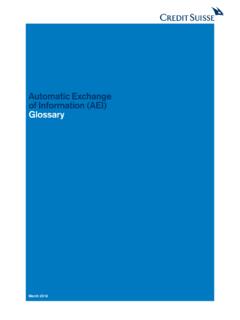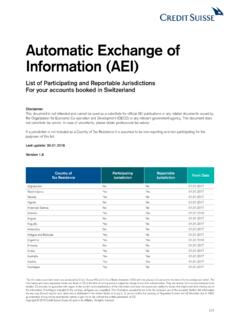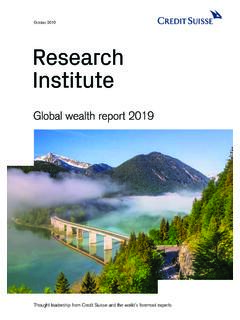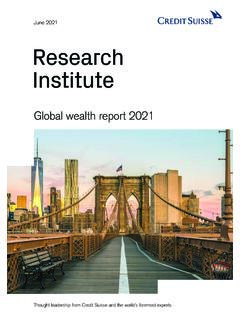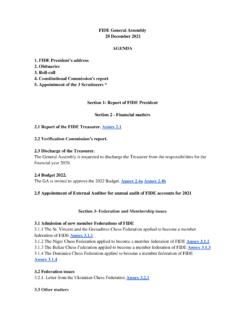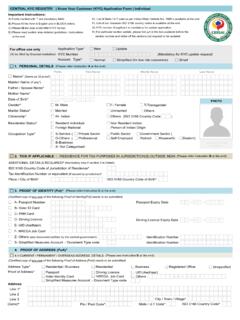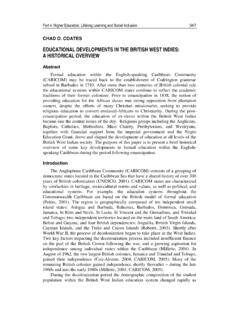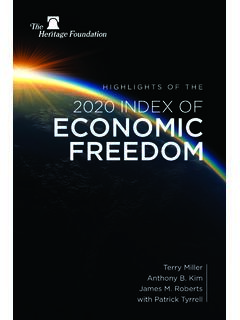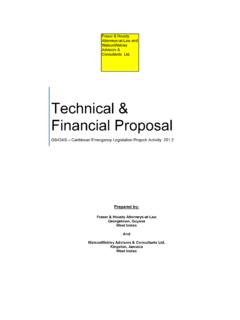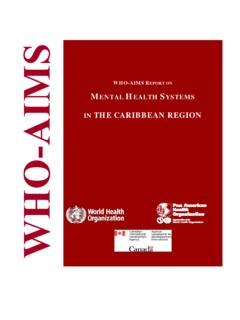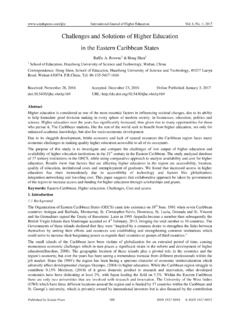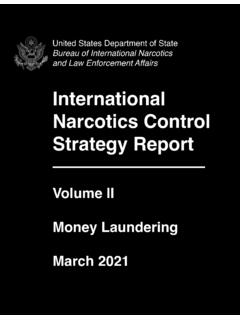Transcription of June 2021 Research Institute - Credit Suisse
1 Research Institute Thought leadership from Credit Suisse and the world s foremost expertsJune 2021 Global wealth databook 2021 2 Preface For the past 12 years, the Credit Suisse Research Institute s Global Wealth Report has been the leading reference on global household wealth. It contains the most comprehensive and up-to-date findings on global wealth across the entire wealth spectrum from the very base of the wealth pyramid, covering billion adults with wealth below USD 10,000, to those at the apex of the wealth pyramid, who now comprise of the adult population and own of household wealth.
2 During the 12 months up to end-2020, and in spite of the economic disruption caused by the COVID-19 pandemic, we estimate that aggregate global wealth has risen by USD trillion (+ ) to a combined total of USD trillion. Wealth per adult grew by 6% to a new record high of USD 79,952 per adult. The core reason for the apparent disconnect between the ongoing global recession in 2020 and household wealth is the pre-emptive action taken by governments and central banks, and the rapid development of COVID vaccines, which combined led to a strong rally in financial the Global Wealth Report highlights the main features of global wealth holdings in recent years, the Credit Suisse Research Institute s Global Wealth Databook provides a great deal more detail.
3 It presents a considerable quantity of additional data on the level and distribution of household wealth across countries, as well as describing the data sources used in the project and the methodology used to obtain the published results. This level of detail sets it apart from other reports in this field. Research for the Global Wealth Report and Global Wealth Databook has been undertaken on behalf of the Credit Suisse Research Institute by Professors Anthony Shorrocks and Jim Davies, recognized authorities on this topic, assisted by Dr. Rodrigo Lluberas. The Credit Suisse Research Institute is Credit Suisse 's in-house think tank.
4 The Institute was established in the aftermath of the 2008 financial crisis with the objective of studying long-term economic developments, which have or promise to have a global impact within and beyond the financial services Global Wealth Databook provides estimates for the level and distribution of wealth for over 200 countries for the period from 2000 to end-2020. It covers the pattern and trend of household wealth at both the regional and country levels. This year s report examines in more detail the development of wealth and wealth distribution in what has been a truly out-of-the-ordinary year.
5 Particular attention is paid to the continued growing importance of China and other emerging economies in global wealth creation, and to the differences across groups of countries that share a number of demographic and economic Hechler-Fayd'herbeChief Investment Officer International Wealth Management and Global Head of Economics & Research , Credit SuisseGlobal wealth databook 2021 3 4 Section 1 Estimating the pattern of global household wealth 9 Table 1-1 Coverage of wealth levels data 10 Table 1-2 Household balance sheet and financial balance sheet sources 12 Table 1-3 Survey sources 14 Table 1-4 Changes in asset prices and exchange rates 2020, selected countries 15 Table 1-5 Wealth shares for countries with wealth distribution data 19 Section 2 Household wealth levels, 2000 20 21 Table 2-1 Country details 25 Table 2-2 (by year)
6 Wealth estimates by country 2000 20 109 Table 2-3 Components of wealth per adult in USD, by region and year 110 Table 2-4 Components of wealth as percentage of gross wealth, by region and year 111 Table 2-5 Changes in household wealth 2020, selected countries 112 Section 3 Estimating the distribution of global wealth 115 Table 3-1 Wealth pattern within countries, 2020 119 Table 3-2 Wealth pattern by region, 2020 120 Table 3-3 Membership of top wealth groups for selected countries, 2020 121 Table 3-4 Percentage membership of global wealth deciles and top percentiles by country of residence, 2020 125 Table 3-5 Main gains and losses in global wealth distribution, 2020 126 Table 3-6 High net worth individuals by country and region, 2020 128 Section 4 Region and country focus 130 Table 4-1 Summary details for regions and selected countries, 2020 131 Table 4-2 Wealth per adult (USD) at current and smooth exchange rates, for regions and selected countries, 2000 20 133 Table 4-3 Total wealth (USD trn)
7 At current and smooth exchange rates, for regions and selected countries, 2000 20 135 Table 4-4 Composition of wealth per adult for regions and selected countries, 2020 136 Table 4-5 Wealth shares and minimum wealth of deciles and top percentiles for regions and selected countries, 2020 137 Table 4-6 Distribution of wealth for regions and selected countries, 2020 140 Bibliography and data references 143 About the authors 144 General disclaimer / Important information 4 Introduction We provide estimates of the wealth holdings of households around the world for each year since 2000. More specifically, we are interested in the distribution within and across nations of individual net worth, defined as the marketable value of financial assets plus non- financial assets (principally housing and land) less debts.
8 No country in the world has a single comprehensive source of information on personal wealth, and many low- and middle-income countries have little direct evidence of any kind. However, a growing number of countries including China and India as well as many high-income countries have relevant data from a variety of different sources, which we are able to exploit in order to achieve our objective. We begin with 227 countries or economically self-governing territories (such as Hong Kong, SAR) whose population sizes are recorded by the United Nations. These include 39 small island states, which, for convenience, we merge into six country groupings.
9 British Caribbean : Anguilla, Antigua and Barbuda, British Virgin Islands, Cayman Islands, Dominica, Grenada, Montserrat, St. Kitts and Nevis, St. Lucia, St. vincent and the grenadines and Turks and Caicos Islands. Dutch Caribbean : Aruba, Bonaire, Sint Eustatius and Saba, Curacao, and St Maarten. French Caribbean : Guadeloupe, Martinique, Saint Barth lemy, Saint Martin, and Saint Pierre and Miquelon. Melanesia: New Caledonia, Solomon Islands, and Vanuatu. Micronesia: Guam, Kiribati, Marshall Islands, Micronesia, Nauru, Northern Mariana Islands, and Palau, Polynesia: American Samoa, Cook Islands, French Polynesia, Niue, Samoa, Tokelau, Tonga, Tuvalu, and Wallis and Futuna Islands These are treated as if they are countries, and their characteristics ( GDP per adult) are the group averages.
10 This reduces the number of countries we consider to the 194 listed in Table 2-1 along with some summary details. Note that China and India are treated as separate regions due to the size of their populations. Our estimation procedure involves three main steps, the first two of which follow the structure set out in Davies et al. (2008, 2011). (See also Davies et al., 2017.) The first step establishes the average level of wealth for each country. The best source of data for this purpose is household balance sheet (HBS) data, which are now provided by 50 countries, although 25 of these countries cover only financial assets and debts.
